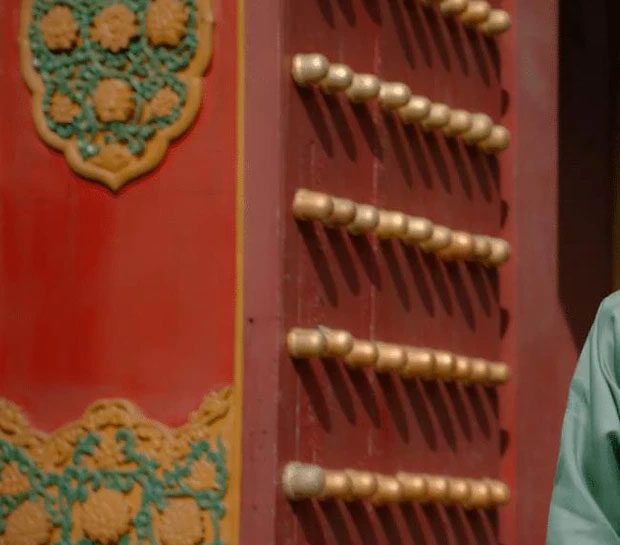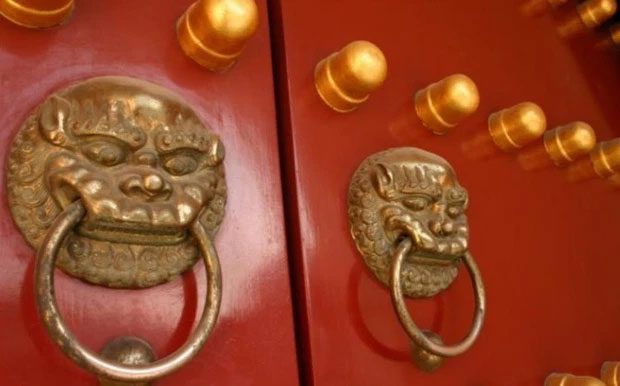Anyone who has visited the Forbidden City or knows about it through films and television series is aware that certain doors of this structure have many “bumpy spots.” Many people are curious about what these protrusions are and what purpose they serve. Additionally, there is great interest in the prohibition against touching them. What secrets lie behind this?
The Origin of the “Bumps”
Today, due to changes in lifestyle, most houses in China no longer feature gateways like those in the Forbidden City. However, in ancient times, this detail was very common, appearing not only on palace gates but also at the entrances of wealthy households. The ancient people referred to these as “door nails.”
Contrary to the imagination of many, these nails were not initially created for aesthetic purposes but rather for practical reasons. In ancient times, raw materials for construction were limited, and the doors of each household were made of wood.
At that time, there were no planks or large trees available, so people could only join smaller pieces of wood together to create a large board. In the case of the gates of the Forbidden City, because of their large size, many pieces of wood had to be assembled together.
During this process, carpenters had to use wooden nails. In some instances, they also used ropes to ensure the joints were sturdy and visually appealing.

The ancient people used round-headed objects to cover the protruding nail ends, preventing injuries. (Illustration: Sohu)
However, this method of joining had a limitation: the heads of the wooden nails would protrude. Since the heads were sharp, people would often get scratched when opening the door. Moreover, the exposed wooden nails were unsightly, prompting the ancients to devise a solution to this problem.
They used round-headed objects to cover the protruding nail ends, preventing injuries. Initially, it was Lu Ban who conceived this idea and implemented it. As a result, the “door nails” came into existence. At first, they were made of wood, which could not withstand wear over the years and was very prone to damage.
Later, Mozi improved and upgraded wooden door nails to copper door nails. Eventually, copper door nails became popular. The nails on the gates of the Forbidden City that we see today are also made of copper.
Door Nails – A Symbol of Authority
Originally, the door nail was just a common object representing the intelligence of the working people in ancient times. However, during the Qing Dynasty, this nail took on a different meaning and became a symbol of “feudal hierarchy.”
In ancient times, the hierarchy was very strict, with the Emperor being the most respected figure in the realm, holding the highest position, followed by officials, then commoners, with status decreasing in order. The Emperor of the Qing Dynasty regarded this nail as a symbol of authority and established regulations regarding the use of door nails.

The Emperor of the Qing Dynasty regarded this nail as a symbol of authority.
For instance, the Qing Dynasty stipulated that only the Emperor’s gate could have 81 door nails, consisting of 9 horizontal and 9 vertical nails. The gates of royal residences could only have 49 door nails, made up of 7 horizontal and 7 vertical nails. The quantity would decrease in accordance with rank. Anyone daring to violate this would face severe punishment.
Additionally, door nails not only served to signify rank but also carried the meaning of prosperity. In popular belief, the door nails on the Forbidden City are particularly special because they embody the aura of royalty, warding off evil spirits.
Records from some literary figures during the Qing Dynasty mention that during the annual Lantern Festival, people would gather at the palace gates to touch the nails on the doors of the Forbidden City in hopes of good luck and to dispel misfortune.
This was the only occasion the Emperor allowed the public to touch the door nails, leading some people to travel thousands of miles just to touch the nails on the Forbidden City gates.
At that time, commoners had the opportunity to touch them only once a year, so it did not significantly affect the nails. Furthermore, these nails were replaced annually to maintain their aesthetic appeal.
Today, Touching is Prohibited
However, with the development and changes in history and society, regulations have changed significantly. Many tourists have heard that the nails on the gates bring good luck, so they wish to touch them when visiting the Forbidden City.

Due to the high volume of visitors, the management has had to implement measures to protect the nails. (Photo: GOV).
Over time, the nails on the gates have gone through more than 600 years of changes in the Forbidden City. They are now a national cultural relic, strictly protected. Therefore, visitors can no longer touch them as freely as before.
Moreover, the Forbidden City is a location with an extremely high foot traffic. Just a light touch from each person would make it difficult for these nails to withstand. Some argue that while they can be replaced if damaged, when it comes to historical relics, how can they be replaced?
Thus, to prevent damage to the door nails, the management of the Forbidden City has devised a method to protect all the door nails with a glass cover. Since then, neither visitors nor anyone else has been allowed to touch these nails.




















































